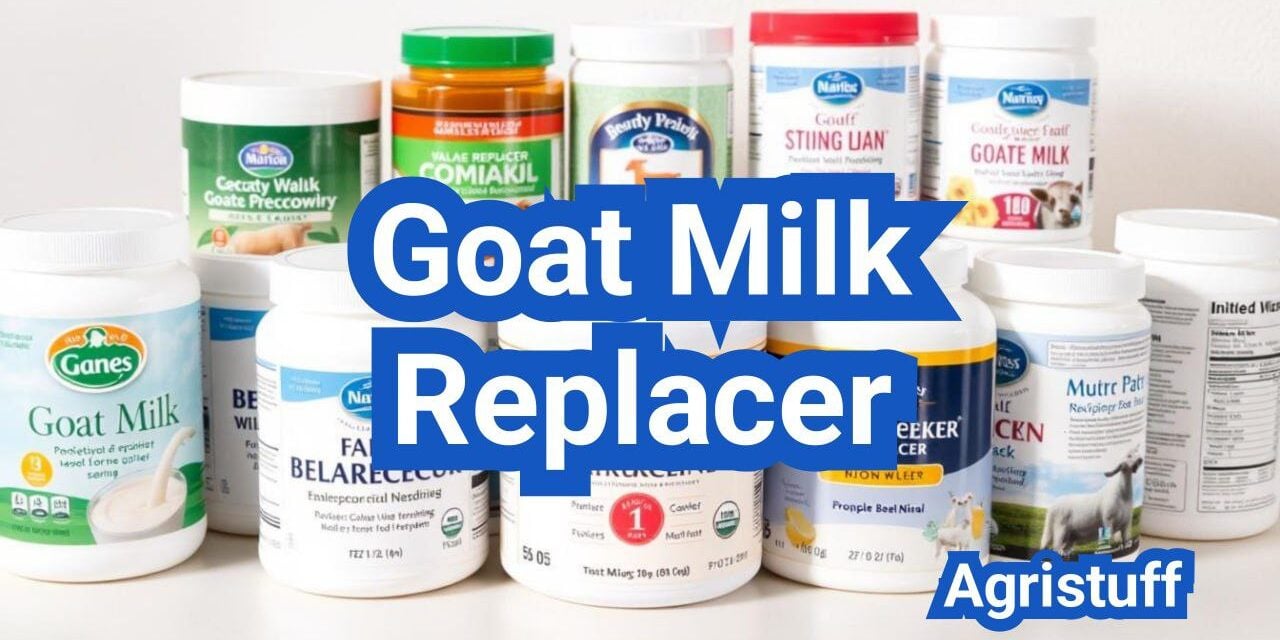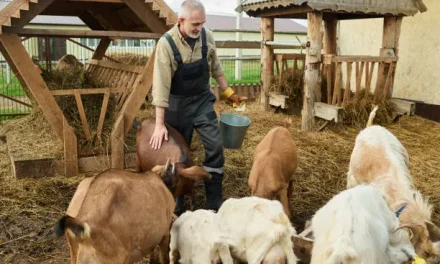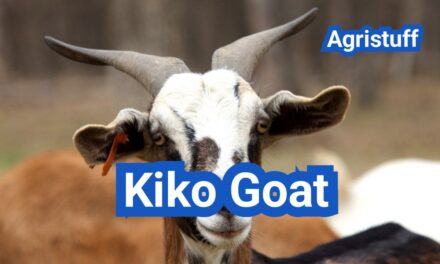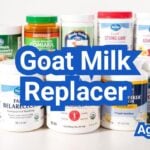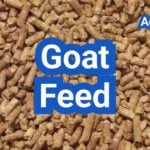Nurturing kid goats requires careful consideration of their nutritional needs, especially when it comes to goat milk replacer. A well-formulated replacer is crucial for their growth and development.
Choosing the right formulas and understanding the correct mixing ratios are vital steps in ensuring kid goats receive the nutrients they need. Additionally, mastering bottle-feeding tips can make a significant difference in their care.
With numerous best goat milk replacer brands available in the U.S., selecting a high-quality product can be daunting. This article aims to guide you through the process, covering essential aspects of goat milk replacer, from preparation instructions to feeding charts.
Key Takeaways
- Understanding the importance of goat milk replacer for kid goats.
- Learning how to choose the right formulas and mixing ratios.
- Mastering bottle-feeding tips for effective care.
- Identifying the best goat milk replacer brands in the U.S.
- Following proper preparation instructions and feeding charts.
The Importance of Proper Kid Nutrition
The nutritional needs of kid goats are a critical factor in their growth and well-being. Providing the right balance of nutrients is essential for their development, health, and future productivity.
“Nutrition is the foundation upon which the health and productivity of kid goats are built,” as emphasized by experts in goat farming. Ensuring that kid goats receive adequate nutrition is vital for their overall health and development.
Why Natural Milk Isn’t Always Available
Natural milk from the doe is not always available due to various reasons such as the doe’s health issues, insufficient milk production, or the need to foster multiple kids. In such cases, a high-quality goat milk replacer becomes indispensable.
Impact of Nutrition on Kid Development
Nutrition has a significant impact on the development of kid goats. Adequate nutrition supports their growth, strengthens their immune system, and enhances their overall health. A well-nourished kid goat is more likely to grow into a healthy, productive adult.
The impact of nutrition on kid development cannot be overstated. Adequate protein, fat, and essential vitamins and minerals are crucial for their growth and development. A deficiency in any of these nutrients can lead to health issues and reduced productivity.
Short and Long-term Health Benefits
Proper nutrition provides both short-term and long-term health benefits for kid goats. In the short term, it supports their immediate growth and health needs. In the long term, it contributes to their overall productivity and longevity.
Using a high-quality goat milk replacer like Land O Lakes can ensure that kid goats receive the necessary nutrients for optimal growth and development. The benefits of proper nutrition are evident in the health and productivity of the kids.
As stated by a renowned goat breeder, “Investing in the right nutrition for kid goats pays dividends in their health, productivity, and overall well-being.”
Understanding Goat Milk Replacer

When natural goat milk isn’t available, a high-quality milk replacer becomes essential. Goat milk replacer is a nutritional substitute designed for kid goats that can’t be fed by their mothers or when the doe’s milk is insufficient.
What Is Goat Milk Replacer?
Goat milk replacer is a powdered or liquid formula that mimics the nutritional profile of doe’s milk. It’s specifically formulated to provide kid goats with the necessary proteins, fats, vitamins, and minerals for healthy growth and development.
Key Ingredients in Quality Replacers
The best goat milk replacers contain high-quality ingredients that are easily digestible by kid goats. Key components typically include:
- Dried whey
- Fat sources (e.g., lard or coconut oil)
- Protein sources (e.g., milk protein or soy)
- Essential vitamins and minerals
- Probiotics for gut health
Differences from Other Livestock Replacers
While the principle of milk replacers is similar across different livestock, the specific formulation for goat kids can differ significantly from those for calves or lambs. For instance, goat milk replacers are often formulated to be less rich than those for calves, reflecting the natural composition of doe’s milk.
| Feature | Goat Milk Replacer | Calf Milk Replacer |
|---|---|---|
| Fat Content | Typically lower | Often higher |
| Protein Sources | Milk protein, soy | Milk protein, other plant proteins |
| Probiotics | Commonly included | Variable inclusion |
Understanding these differences is crucial for selecting the right milk replacer for kid goats. Products like Manna Pro Kid Colostrum are designed to meet the specific nutritional needs of newborn goats, highlighting the importance of choosing a replacer that is tailored to the needs of goat kids.
Nutritional Requirements of Kid Goats
Understanding the nutritional requirements of kid goats is crucial for their healthy development. Kid goats need a balanced diet that includes essential nutrients to support their rapid growth and development.
Essential Nutrients for Growing Kids
Growing kid goats require a diet rich in essential nutrients, including proteins, fats, carbohydrates, vitamins, and minerals. Proteins are particularly important as they support muscle development and overall growth. According to nutritional experts, “Kids require a high-protein diet to develop properly, especially in the first few months of life.”
“A diet lacking in essential nutrients can lead to stunted growth, weakened immune systems, and increased susceptibility to diseases.”
Key nutrients include:
- Protein: crucial for muscle and tissue development
- Fat: provides energy and supports the development of the nervous system
- Carbohydrates: serve as a primary energy source
- Vitamins and Minerals: essential for various bodily functions, including immune response and bone development
Protein and Fat Balance Needs
The balance between protein and fat is critical in a kid goat’s diet. Doe’s milk, or natural milk from the mother, typically contains around 4-6% fat and 3-4% protein. Commercial milk replacers aim to mimic this balance to ensure kids receive the necessary nutrients for growth.
| Nutrient | Doe’s Milk (%) | Commercial Replacer (%) |
|---|---|---|
| Protein | 3-4 | 20-24 |
| Fat | 4-6 | 20-30 |
Comparing Doe’s Milk to Commercial Replacers
Doe’s milk is considered the gold standard for kid nutrition. However, commercial milk replacers are formulated to closely match its nutritional profile. Commercial replacers are often more consistent in quality and can be fortified with additional nutrients. When choosing a commercial replacer, it’s essential to compare its nutritional content to that of doe’s milk to ensure it meets the needs of growing kids.
By understanding and meeting the nutritional requirements of kid goats, caregivers can ensure these young animals grow into healthy, productive adults.
Types of Goat Milk Replacer Formulas

Understanding the different types of goat milk replacer formulas is crucial for the healthy development of kid goats. The nutritional needs of kid goats can vary based on factors such as age, health status, and developmental stage.
Powder vs. Liquid Formulations
Goat milk replacers are available in both powder and liquid formulations. Powdered formulas are more common and often preferred for their longer shelf life and ease of storage. They require mixing with water according to the manufacturer’s instructions to achieve the correct concentration.
Key Considerations for Powdered Formulas:
- Ensure proper mixing to avoid under or over-concentration.
- Store in a cool, dry place to maintain quality.
Liquid formulations, on the other hand, offer convenience as they are ready to use or require minimal preparation. However, they typically have a shorter shelf life and may require refrigeration.
Medicated vs. Non-Medicated Options
Some goat milk replacers are medicated to help prevent certain health issues in kid goats, such as coccidiosis. Medicated formulas contain additives like decoquinate or lasalocid that are designed to support the health of the kids.
When to Choose Medicated Options:
- In environments where disease pressure is high.
- For kids that are at higher risk due to health or environmental factors.
Non-medicated formulas are suitable for kids that are not at high risk of disease and are often used in conjunction with other health management practices.
Age-Specific Formula Variations
Goat milk replacer formulas can be age-specific, catering to the different nutritional needs of kid goats at various stages of development. For example, younger kids require a formula that is rich in proteins and fats to support their rapid growth and development.
| Age Group | Nutritional Needs | Recommended Formula Type |
|---|---|---|
| 0-3 weeks | High protein, high fat | Starter formula |
| 4-8 weeks | Moderate protein, moderate fat | Grower formula |
| 9 weeks and above | Lower protein, lower fat | Finisher formula |
Selecting the right type of goat milk replacer formula is crucial for ensuring that kid goats receive the nutrients they need for healthy growth and development. By understanding the different formulations available and the specific needs of your kids, you can make informed decisions to support their health.
Best Goat Milk Replacer Brands in the U.S.
For goat farmers in the United States, selecting the right milk replacer is crucial, with several reputable brands available. The quality of goat milk replacer can significantly impact the health and development of kid goats, making it essential to choose a reliable brand.
Land O Lakes Doe’s Match
Land O Lakes is a well-known brand in the agricultural sector, and their Doe’s Match goat milk replacer is designed to mimic the nutritional profile of doe’s milk. It is formulated with high-quality ingredients to support the growth and development of kid goats. Farmers appreciate the consistency and reliability of Land O Lakes products.
Manna Pro Goat Kid Milk Replacer
Manna Pro is another respected brand that offers a comprehensive goat kid milk replacer. Their product is designed to provide essential nutrients for young goats, supporting their overall health and well-being. Manna Pro’s formula is known for being easy to mix and digest, reducing the risk of digestive issues in kids.
Shepherd’s Choice Products
Shepherd’s Choice is a brand that caters specifically to the needs of sheep and goat farmers. Their milk replacer products are formulated to meet the nutritional requirements of kid goats, with a focus on high protein content to support growth. Shepherd’s Choice is recognized for its commitment to quality and customer satisfaction.
Other Quality American Brands
In addition to Land O Lakes, Manna Pro, and Shepherd’s Choice, there are other quality American brands available. These include Purina, AGP, and Cargill, among others. Each of these brands offers unique formulations and benefits, giving farmers a range of options to choose from based on their specific needs and preferences.
Homemade Goat Milk Replacer Recipes

Homemade goat milk replacer recipes have gained popularity among goat breeders seeking more control over their kids’ nutrition. While commercial replacers are convenient, homemade formulas can offer flexibility and potentially lower costs. However, it’s crucial to ensure that any homemade recipe meets the nutritional needs of the kids.
Emergency DIY Formulas
In situations where a commercial goat milk replacer is not available, an emergency DIY formula can be a lifesaver. A simple recipe involves mixing:
- 1 quart of cow’s milk
- 1 egg yolk
- 1 teaspoon of vegetable oil
- A pinch of salt
- 1 tablespoon of honey or sugar
This mixture provides a temporary solution but should be used with caution and ideally under veterinary guidance.
Whole Milk Based Recipes
Whole milk-based recipes are another option for homemade goat milk replacers. These can be particularly useful when cow’s milk is readily available. A basic whole milk recipe includes:
- Mix 1 quart of whole milk with 1 tablespoon of butter or vegetable oil to increase the fat content.
- Add 1 egg yolk to enhance the protein and nutrient profile.
- Optionally, add a probiotic supplement to support gut health.
It’s essential to note that these recipes should be used as a substitute only when commercial replacers are not available.
Pros and Cons of Homemade Options
Homemade goat milk replacer recipes have both advantages and disadvantages. The pros include:
- Potential cost savings
- Control over ingredients
- Flexibility in formulation based on the kids’ needs
The cons include:
- Nutritional imbalance if not formulated correctly
- Lack of specific nutrients found in commercial replacers
- Time-consuming preparation
It’s crucial to weigh these factors and ideally consult with a veterinarian before opting for homemade recipes.
Colostrum Replacers for Newborn Kids
Colostrum replacers play a vital role in the health and well-being of newborn goat kids. These products are designed to provide essential nutrients and antibodies when the mother’s colostrum is not available.
Importance of First Feeding
The first feeding is critical for newborn kids, as it provides them with the necessary antibodies to fight off infections. Colostrum is rich in proteins, vitamins, and minerals that are essential for the kid’s development.
Key Benefits of Colostrum Replacers:
- Provides essential antibodies
- Supports the development of the kid’s immune system
- Helps in the overall growth and development of newborn kids
Commercial Colostrum Products
Several commercial colostrum products are available in the market, catering to the needs of newborn goat kids. These products are formulated to mimic the nutritional profile of natural colostrum.
| Product | Description | Key Features |
|---|---|---|
| Manna Pro Kid Colostrum | A supplement for newborn kids | Provides essential antibodies, easy to mix |
| Land O’Lakes Colostrum Replacer | Replaces or supplements maternal colostrum | High-quality protein sources, supports immune system |
Manna Pro Kid Colostrum Options
Manna Pro Kid Colostrum is a popular choice among goat breeders. It is designed to provide newborn kids with the necessary antibodies and nutrients.
“Manna Pro Kid Colostrum is a reliable and effective solution for ensuring newborn kids receive the nutrients they need for a healthy start in life.”
In conclusion, colostrum replacers are a vital component in the care of newborn goat kids. By understanding their importance and choosing the right product, breeders can ensure the health and well-being of their animals.
Goat Milk Replacer Mixing Ratios

To provide optimal nutrition, it’s critical to understand the correct mixing ratios for goat milk replacer. The right balance ensures kid goats receive the necessary nutrients for healthy growth and development.
Standard Mixing Instructions
Most goat milk replacers come with standard mixing instructions that typically involve mixing a specific amount of powder with water. For example, a common ratio is 1 scoop of powder to 4 parts water, but this can vary depending on the product.
Always follow the manufacturer’s guidelines for the specific product you’re using, as the recommended mixing ratio can differ.
Age-Specific Mixing Ratios
The age of the kid goat can affect the ideal mixing ratio. Younger kids may require a richer mixture to support their rapid growth and development.
- 0-3 days: Often require colostrum or a specialized starter formula.
- 3 days to weaning: Typically follow the standard mixing ratio provided by the manufacturer.
Temperature Considerations
The temperature of the water used for mixing is crucial. It should be warm enough to dissolve the powder properly but not so hot that it damages the nutrients.
“The ideal temperature for mixing goat milk replacer is around 100°F to 105°F (38°C to 40°C), similar to the natural temperature of a doe’s milk.”
Using water within this temperature range helps ensure the mixture is comfortable for the kid goats to consume.
Common Mixing Mistakes to Avoid
Several common mistakes can occur when mixing goat milk replacer, including using the wrong water temperature, not measuring the powder accurately, and not mixing thoroughly.
| Mistake | Consequence | Solution |
|---|---|---|
| Incorrect water temperature | Nutrient damage or discomfort for the kid | Use water between 100°F and 105°F |
| Inaccurate measurement | Over or under-nutrition | Use a precise measuring scoop |
| Insufficient mixing | Uneven nutrient distribution | Mix thoroughly until powder is fully dissolved |
Step-by-Step Milk Replacer Preparation

To ensure the health and well-being of kid goats, it’s crucial to prepare milk replacer correctly. Proper preparation involves several key steps, from selecting the right equipment to storing the prepared replacer. Farmers can easily obtain high-quality goat milk replacer from suppliers like Tractor Supply, making it easier to follow these guidelines.
Equipment Needed
Before starting, gather all necessary equipment to ensure a smooth process. You’ll need:
- A clean bucket or container for mixing
- A measuring cup or scale for accurate measurements
- A stirring rod or spoon for mixing
- Bottles or a feeding system for the kids
Having the right equipment is crucial for preparing milk replacer efficiently and safely.
Measuring and Mixing Process
The measuring and mixing process is critical to ensure the milk replacer is prepared correctly. Follow these steps:
- Measure the water according to the manufacturer’s instructions.
- Add the recommended amount of milk replacer powder to the water.
- Stir thoroughly until the powder is fully dissolved.
It’s essential to follow the manufacturer’s guidelines for the correct ratio of water to powder to ensure the nutritional needs of the kid goats are met.
Storage Guidelines
Proper storage of prepared milk replacer is vital to maintain its quality and safety. Here are some guidelines:
| Storage Method | Duration |
|---|---|
| Refrigerated | Up to 24 hours |
| Room Temperature | Up to 6 hours |
Always store prepared milk replacer in a clean, covered container to prevent contamination.
Batch Preparation Tips
Preparing milk replacer in batches can be convenient, but it requires careful planning. Here are some tips:
- Prepare only what you need to avoid waste.
- Label containers with the date and time prepared.
- Use the oldest prepared replacer first.
Batch preparation can save time, but it’s crucial to follow proper handling and storage procedures to maintain the quality of the milk replacer.
Bottle-Feeding Baby Goats: Complete Guide

Successfully raising baby goats on a bottle demands attention to detail in both the equipment used and the feeding process itself. Bottle-feeding is a critical skill for anyone raising goats, as it ensures that the kids receive the necessary nutrition for healthy growth and development.
Selecting the Right Bottles and Nipples
Choosing the appropriate bottles and nipples is the first step in successful bottle-feeding. Goat-specific bottles and nipples are designed to mimic the natural feeding experience as closely as possible. When selecting equipment, consider the following:
- The size and material of the bottles
- The type of nipple that best suits the kids (e.g., lamb nipples are often recommended)
- Ease of cleaning and durability
Proper Feeding Position and Technique
The position and technique used during feeding are crucial for the kid’s comfort and to prevent complications such as choking. Hold the bottle at an angle that allows the kid to feed comfortably without gulping air. Ensure the nipple is always filled with milk to prevent air intake.
Some key points to remember:
- Always hold the kid securely but gently during feeding.
- Monitor the kid’s response to the feeding to adjust the technique as needed.
- Be patient, as some kids may take time to adjust to bottle-feeding.
Teaching Reluctant Kids to Bottle Feed
Some kids may be hesitant to take to bottle-feeding initially. To encourage them, start by gently introducing the nipple into their mouth, allowing them to become accustomed to it. If they continue to refuse, try dipping the nipple in a small amount of milk to entice them.
Patience and consistency are key when teaching reluctant kids to bottle feed. It may take some time for them to become comfortable with the process.
Cleaning and Sanitizing Equipment
Proper cleaning and sanitizing of the feeding equipment are vital to prevent the spread of disease. After each feeding, thoroughly clean the bottles and nipples with warm, soapy water, and then sanitize them. Regularly inspect the equipment for signs of wear and replace as necessary.
- Use a bottle brush to scrub the inside of the bottles.
- Sanitize by submerging the equipment in hot water or using a sanitizing solution.
- Allow the equipment to air dry to prevent bacterial growth.
Goat Kid Feeding Schedule
Understanding the feeding needs of goat kids at different stages is vital for their growth. A goat kid feeding schedule is crucial for ensuring that these young animals receive the necessary nutrition for healthy development.
Newborn to One Week
For newborn goat kids, the first week is critical. They require colostrum in the first 24 hours, followed by a milk replacer that mimics the nutritional profile of their mother’s milk. Feeding should occur every 2-3 hours, around the clock.
One Week to One Month
As the kids grow, the frequency of feeding can be gradually reduced. From one week to one month, kids typically require feeding 3-4 times a day. It’s essential to monitor their health and adjust the feeding schedule as necessary.
One Month to Weaning
Between one month and weaning age (usually around 8-10 weeks), kids can be fed 2-3 times a day. The amount of milk replacer can be adjusted based on their consumption of solid foods.
Adjusting for Multiple Kids
When raising multiple kids, it’s crucial to ensure each kid receives adequate nutrition. This may involve adjusting the feeding schedule to accommodate the needs of all kids, potentially requiring more frequent feeding or the use of additional feeding equipment.
Key Considerations for a Goat Kid Feeding Schedule:
- Monitor kid health and adjust feeding accordingly
- Gradually introduce solid foods
- Consider the nutritional needs at different growth stages
- Adjust feeding frequency and amount based on age and development
By following a well-structured goat kid feeding schedule, farmers can ensure their kids grow into healthy, thriving adults.
Alternative Feeding Methods
When it comes to feeding kid goats, farmers often explore alternative methods beyond traditional bottle-feeding. This section delves into various alternative feeding methods that can simplify the process and ensure the kids receive adequate nutrition.
Bucket Feeding Systems
Bucket feeding systems are a popular alternative for feeding kid goats. These systems allow multiple kids to feed simultaneously, reducing the labor involved in feeding.
- Easy to clean and maintain
- Reduces feeding time significantly
- Can be used for both milk replacer and water
Lamb Bar Feeders
Lamb bar feeders, while designed for lambs, can also be effectively used for kid goats. They provide a convenient way to offer milk replacer or other nutrients.
Key benefits include:
- Prevents kids from getting into the feeder
- Easy to fill and clean
- Encourages natural feeding behavior
Tube Feeding in Emergencies
In emergency situations where kid goats are too weak to feed normally, tube feeding can be a lifesaver. This method requires careful handling to avoid causing harm.
Precautions to take:
- Use a properly sized tube
- Ensure the tube is correctly placed
- Feed at a comfortable temperature
| Feeding Method | Advantages | Disadvantages |
|---|---|---|
| Bucket Feeding | Reduces labor, easy to clean | Potential for overfeeding |
| Lamb Bar Feeders | Prevents access issues, easy to fill | Initial investment cost |
| Tube Feeding | Lifesaving in emergencies | Requires skill and caution |
Health Issues Related to Milk Replacer

Milk replacer is a vital tool for raising kid goats, but it can also lead to health issues if not managed properly. One of the most significant health concerns associated with milk replacer is scours, a condition characterized by diarrhea that can lead to dehydration and other complications.
Preventing Milk Replacer Scours
Preventing scours involves careful management of the milk replacer. This includes using high-quality replacer that is formulated to meet the nutritional needs of kid goats, mixing it correctly to avoid over or under-concentration, and ensuring that feeding equipment is clean and sanitized.
Tips for Preventing Scours:
- Use a high-quality milk replacer that is appropriate for kid goats.
- Follow the manufacturer’s instructions for mixing ratios.
- Keep feeding equipment clean and sanitized.
- Monitor kid goats for signs of scours or digestive issues.
Signs of Digestive Problems
Kid goats experiencing digestive problems may show signs such as diarrhea, lethargy, loss of appetite, or bloating. It’s crucial to identify these signs early to provide timely intervention.
Common Signs of Digestive Issues:
| Sign | Description |
|---|---|
| Diarrhea | Loose or watery stools |
| Lethargy | Lack of energy or activity |
| Loss of Appetite | Reduced interest in feeding |
| Bloating | Swelling of the abdomen |
When to Consult a Veterinarian
If kid goats show persistent or severe signs of digestive issues, it’s essential to consult a veterinarian. A professional can diagnose the underlying cause and recommend appropriate treatment.
Reasons to Consult a Veterinarian:
- Persistence or severity of digestive symptoms.
- Signs of dehydration or weight loss.
- Presence of blood in stool or other abnormal stool characteristics.
Adjusting Formula for Sensitive Kids
Some kid goats may be more sensitive to certain ingredients in milk replacer. Adjusting the formula to avoid these ingredients or using a different type of milk replacer can help alleviate issues.
By understanding and addressing potential health issues related to milk replacer, goat breeders can help ensure the health and well-being of their kid goats.
Weaning Kids from Milk Replacer
Successfully weaning kids from milk replacer involves understanding their nutritional needs and implementing a gradual transition to solid foods. This process is crucial for the long-term health and development of the kids.
When to Begin the Weaning Process
The ideal time to start weaning kids from milk replacer depends on their age and development. Generally, kids can start being weaned off milk replacer around 8 to 10 weeks of age. However, this can vary based on factors such as breed, size, and overall health.
Gradual Weaning Techniques
Gradual weaning is key to preventing digestive upset and stress in kids. Start by reducing the frequency of milk replacer feeding by one session every few days until they are completely weaned. Monitoring their health and adjusting the weaning schedule as needed is crucial.
Gradual Weaning Schedule Example:
| Week | Milk Replacer Feedings per Day | Solid Food Introduction |
|---|---|---|
| 1 | 4 | Starter feed introduction |
| 2 | 3 | Increase starter feed |
| 3 | 2 | Continue increasing starter feed |
| 4 | 1 | Maximize starter feed and hay |
| 5 | 0 | Full transition to solid foods |
Transitioning to Solid Foods
Introducing solid foods, such as high-quality hay and goat starter feed, is a vital part of the weaning process. Ensure that the kids have access to fresh water and that the solid foods are nutrient-rich to support their growth.
Post-Weaning Nutrition
After weaning, kids require a balanced diet that includes a mix of hay, grains, and possibly supplements if necessary. Ensuring they receive adequate nutrition post-weaning is critical for their continued growth and development.
Post-weaning dietary adjustments should be made based on the kids’ health, growth rate, and nutritional needs.
Using Goat Milk Replacer for Other Animals
The versatility of goat milk replacer makes it suitable for feeding a range of young animals beyond just goats. While it is formulated to meet the nutritional needs of kid goats, its composition can also be beneficial for other young livestock.
Goat Milk Replacer for Puppies
Goat milk replacer can be a nutritious alternative for puppies, especially those that are orphaned or unable to nurse from their mother. It provides essential nutrients and can be easier on their digestive system compared to traditional puppy milk replacers.
Nutritional Benefits: Rich in proteins and fats, goat milk replacer supports the healthy growth and development of puppies.
Goat Milk Replacer for Kittens
Similarly, kittens can benefit from goat milk replacer, particularly in situations where they are orphaned. The nutritional profile of goat milk is close to that of cat’s milk, making it a suitable substitute.
Precautions: It’s crucial to consult with a veterinarian before making any changes to a kitten’s diet to ensure that their nutritional needs are fully met.
Adaptations for Lambs and Other Livestock
Lambs and other young livestock can also be fed with goat milk replacer, provided that the formulation is adjusted according to their specific nutritional requirements.
| Animal | Nutritional Needs | Feeding Recommendations |
|---|---|---|
| Puppies | High protein, moderate fat | Mix according to manufacturer’s instructions, potentially adjusting concentration based on puppy’s size and age. |
| Kittens | High protein, high fat | Similar to puppies, with careful monitoring of kitten’s health and adjustment as necessary. |
| Lambs | High protein, specific vitamin and mineral profile | May require additional supplements to match lambs’ nutritional needs; consult with a veterinarian. |
In conclusion, goat milk replacer can be a valuable resource for feeding various young animals. However, it’s essential to understand the specific nutritional needs of each species and adjust the feeding regimen accordingly.
Ensuring Kid Goat Success
Providing kid goats with the right nutrition is crucial for their development and long-term health. Goat milk replacer plays a vital role in ensuring kid goats receive the necessary nutrients when natural milk isn’t available. Land O Lakes Doe’s Match Kid Milk Replacer is a trusted brand that offers a nutritionally balanced formula, supporting the growth and well-being of kid goats.
The nutritional needs of kid goats are specific, and using a high-quality goat milk replacer helps meet these requirements. Proper mixing ratios and bottle-feeding techniques are also essential for kid goat success. By following the guidelines outlined in this article, farmers and caregivers can give kid goats the best possible start in life.
Ultimately, the success of kid goats depends on receiving adequate nutrition, especially during the early stages of life. By choosing a reliable goat milk replacer and adhering to recommended feeding practices, caregivers can significantly impact the health and productivity of their kid goats. Ensuring kid goat success is a multifaceted process, and proper nutrition is a foundational element.
FAQ
What is goat milk replacer, and why is it important for kid goats?
Goat milk replacer is a nutritional substitute for natural milk, providing essential nutrients for growing kid goats. It’s crucial when natural milk isn’t available or sufficient.
How do I choose the best goat milk replacer for my kid goats?
Consider factors like nutritional content, protein and fat balance, and age-specific formulas. Brands like Land O Lakes, Manna Pro, and Shepherd’s Choice are highly recommended.
What are the key ingredients in a quality goat milk replacer?
Look for high-quality protein sources, balanced fat content, complex carbohydrates, and essential vitamins and minerals.
Can I use cow milk replacer for my kid goats?
While possible, it’s not recommended as goat milk replacers are specifically formulated to meet the nutritional needs of kid goats.
How do I mix goat milk replacer correctly?
Follow the manufacturer’s instructions for mixing ratios, and ensure the water is at the correct temperature. Typically, a ratio of 1 part powder to a specified amount of water is used.
What is the ideal feeding schedule for kid goats?
Feed kid goats according to their age: newborn to one week, one week to one month, and one month to weaning, adjusting for multiple kids as needed.
Can I use goat milk replacer for other animals like puppies or kittens?
Yes, goat milk replacer can be used for other animals, but adaptations may be necessary to meet their specific nutritional needs.
How do I wean kid goats from milk replacer?
Gradually introduce solid foods while reducing milk replacer over a period of time, typically around 8-10 weeks of age.
What are the signs of digestive problems in kid goats related to milk replacer?
Watch for signs like scours, diarrhea, or lethargy, and consult a veterinarian if issues persist.
Can I make homemade goat milk replacer?
While possible, homemade recipes may not provide the balanced nutrition found in commercial replacers. Use with caution and consult a veterinarian.
Where can I buy goat milk replacer?
Goat milk replacer is available at Tractor Supply and other livestock supply stores, as well as online retailers.
What is colostrum replacer, and why is it important for newborn kid goats?
Colostrum replacer provides essential antibodies and nutrients for newborn kid goats, crucial for their initial health and development.
How do I bottle-feed baby goats?
Use the right equipment, ensure proper feeding position and technique, and clean and sanitize equipment regularly.
Conclusion of: Goat Milk Replacer
Goat milk replacer basics and why it matters
Goat milk replacer is a dry, shelf-stable formula that you mix with warm water to create a milk-like feed for newborn and young kids. It’s used when a doe can’t nurse, when milk supply is short, or when you want a consistent, biosecure feeding program. Because kids are “pre-ruminants” for several weeks, their growth depends heavily on liquid nutrition, so choosing and using goat milk replacer correctly can make the difference between a thriving kid and one that struggles early. FAO livestock feeding resources
Common situations where goat milk replacer is the best option
Producers reach for goat milk replacer in several real-life cases: orphaned kids, large litters where the doe can’t keep up, dairy herds that remove kids to protect sale milk, or health problems like mastitis that make nursing risky. Goat milk replacer also helps when you’re trying to raise multiple kids on the same schedule, because each bottle has predictable nutrition. If your goals include uniform growth, easier record-keeping, and fewer disease surprises, goat milk replacer is often the simplest tool. University of Maine goat extension
Colostrum always comes first before goat milk replacer
No goat milk replacer can substitute for colostrum in the first hours of life. Colostrum provides antibodies that protect kids from early infections, plus nutrients that kick-start energy and gut function. Plan to feed high-quality colostrum or a trusted colostrum replacer during the first 18–24 hours, then transition to goat milk replacer. Skipping this step is a common reason bottle-raised kids get sick, even when the milk replacer is excellent. Iowa State colostrum management
What nutrients a good goat milk replacer should provide
The best goat milk replacer formulas are designed to imitate doe milk as closely as possible. At a minimum, you want a product with balanced protein for muscle growth, adequate fat for energy and warmth, lactose for quick calories, plus vitamins and minerals for immune and skeletal development. Many reputable products land around the mid-20% range for protein and fat on a dry-matter basis, because that profile supports strong daily gains in kids. Purina goat feeding education
All-milk proteins beat plant proteins in goat milk replacer
When reading labels, choose goat milk replacer made from milk-derived proteins like whey, skim milk, or casein. These digest more naturally for kids than soy or other plant proteins, which can be harder on immature digestive systems and sometimes lead to softer stools or slower growth. You don’t need a “premium” price tag for success, but you do want a formula where milk ingredients make up the core protein source. Merck Veterinary Manual: goat nutrition
Medicated vs. non-medicated goat milk replacer
Some goat milk replacer products include a coccidiostat (often called “medicated”) to help reduce coccidiosis risk in high-density housing. Non-medicated formulas are fine for low-pressure environments or when you follow a separate, vet-approved coccidia prevention plan. The key is consistency: frequent switching between medicated and non-medicated goat milk replacer can stress digestion and make it harder to interpret health changes. AVMA overview of coccidiosis
Mixing ratios: the label is law, but here’s the logic
Always follow the label for your goat milk replacer brand, since scoop sizes and powder density vary. Most products aim for a final mix of roughly 15–20% total solids, which produces a milk-like concentration kids can digest. If you “eyeball it” and accidentally mix too strong, you raise the risk of scours; too weak and kids may lag in growth. If possible, weigh the powder for repeatable accuracy. Premier1 goat kid supply guides
Water temperature matters for goat milk replacer digestion
Use warm water so goat milk replacer dissolves evenly and fats stay emulsified. Many manufacturers recommend mixing into water around 125–135°F (52–57°C), then cooling the bottle to feeding temperature. Overly hot water can damage proteins; overly cool water can leave fat clumps and create an uneven bottle that’s tougher to digest. Smooth, fully dissolved replacer is gentler on the gut. Manna Pro goat feeding tips
Feeding temperature and schedule for goat milk replacer
Kids accept goat milk replacer best at body temperature—about 102–103°F (39–39.5°C). In the first week, most kids do well with 3–4 evenly spaced feedings daily. As they grow, you can shift toward fewer, larger bottles if stools stay normal and weight gain remains steady. The biggest rule is consistency: sudden timing gaps or volume jumps are among the top causes of bottle-kid digestive upset. Goat Journal bottle-feeding guide
How much goat milk replacer to feed by weight
A practical target is to feed reconstituted goat milk replacer at about 10–12% of body weight per day, split into multiple bottles. Smaller or weaker kids may need slightly higher frequency with smaller volumes. Watch the kid’s belly after feeding—it should be comfortably rounded, not tight or drum-like. Pair amounts with weekly weigh-ins to confirm the goat milk replacer program is delivering real growth, not just full bellies. Cornell CCE kid feeding chart
Bottle-feeding technique that prevents aspiration
Proper bottle technique keeps goat milk replacer in the stomach, not the lungs. Hold the bottle so the nipple stays full, and let the kid suck in a natural nursing posture with its neck slightly extended. Avoid squeezing the bottle to “speed things up,” because force-feeding can cause aspiration pneumonia. Use nipples with a flow that drips when inverted rather than streams. Oklahoma State newborn kid management
Bucket or bar feeding with goat milk replacer
Once kids are vigorous and reliably drinking, you can transition goat milk replacer from bottles to bucket nipples or bar feeders to save time. Keep the same mixing ratio during the switch so only the delivery method changes. Train kids by dipping a finger in warm replacer, letting them suck, then guiding their mouth to the nipple. Bucket systems work best when cleaned daily and kept at consistent height. NSW DPI artificial rearing notes
Hygiene rules for goat milk replacer success
Because goat milk replacer is rich in sugar and protein, bacteria grow quickly if equipment isn’t washed well. Rinse bottles or buckets immediately, scrub with hot soapy water, sanitize, and air-dry. Mixed replacer should be refrigerated promptly and used within 24 hours. Any goat milk replacer left warm for a long stretch should be discarded—saving a bottle is never worth the health risk. CDC pet and livestock food safety basics
Troubleshooting scours on goat milk replacer
If a kid scours on goat milk replacer, start by checking mixing accuracy and feeding consistency. Most cases come from over-concentrated bottles, cold milk, infrequent feedings, or stress such as chilling. Reduce bottle size temporarily, return to consistent intervals, and ensure hydration. If stools become watery, blood-tinged, or the kid seems weak, involve a veterinarian quickly while maintaining careful goat milk replacer management. Merck Vet Manual: diarrhea in goats
Preventing bloat and overeating with goat milk replacer
Bloat can happen when kids drink goat milk replacer too fast, swallow air, or get large volumes after a long gap. Use an appropriate nipple flow, keep feeding intervals steady, and don’t let hungry kids “catch up” with an oversized bottle. A kid that’s stretched out, uncomfortable, or has a hard left side needs immediate attention. Prevention is mostly about calm, consistent goat milk replacer feeding. Penn State Extension on bloat
How goat milk replacer fits into early rumen development
Even while goat milk replacer is the main diet, kids should get access to fresh water and a high-quality starter or creep feed from the first week. Tiny nibbles stimulate rumen growth, setting the stage for smooth weaning. If kids stay on liquid only, rumen development slows and weaning becomes harder. Goat milk replacer works best as part of a full early-life pathway, not a stand-alone fix. Langston University goat program
Weaning off goat milk replacer without a growth slump
Most kids wean successfully between 6–10 weeks, depending on breed, growth rate, and management goals. Start tapering goat milk replacer only when kids are eating starter steadily for several days. Reduce volume gradually over 1–2 weeks rather than stopping suddenly. A slow step-down protects the gut, keeps kids confident, and prevents the common “weaning dip” in weight gain. Purina weaning guidance
Special cases: multiples, cold weather, and weak kids
Twins and triplets raised on goat milk replacer often need closer monitoring, because smaller kids may lose milk-sharing battles or tire during long bottles. In cold weather, kids burn more calories to stay warm, so you may need an extra feeding or slightly higher daily total while keeping the same mixing strength. Weak kids benefit from smaller, more frequent goat milk replacer bottles until their sucking reflex improves. University of Minnesota kid care
Choosing a goat milk replacer brand: practical buying checklist
When choosing goat milk replacer, focus on label ingredients and farm fit rather than marketing. Pick all-milk protein as the base, an energy-supportive fat level, clear mixing directions, and a company with consistent supply. Also consider your feeding system: some replacers mix better for bucket feeding, others for bottles. If your kids are doing well, avoid unnecessary brand hopping—stability is a hidden advantage in goat milk replacer programs. Sav-A-Caf/Sav-A-Kid product info
Final thought
Goat milk replacer is one of the most useful tools in kid rearing when it’s chosen wisely and fed with care. Colostrum first, accurate mixing, warm consistent bottles, spotless equipment, and gradual weaning will get you results that rival natural nursing. If you treat goat milk replacer as a precise nutrition program—not a rough substitute—you’ll raise sturdy, fast-growing kids with fewer health setbacks. Extension.org goat resource hub
Sources & References
These references support the principles and best practices discussed for goat milk replacer selection and feeding.
- Purinamills.com/goat-feed/
- Purina Animal Nutrition – Goat kid milk replacer and weaning education
- Premier1 Supplies – Kid milk replacer mixing and feeding directions
- Sav-A-Caf / Sav-A-Kid – Commercial goat milk replacer formulation notes
- Cornell Cooperative Extension – Bottle feeding and kid growth guidance
- Merck Veterinary Manual – Goat nutrition and diarrhea troubleshooting

